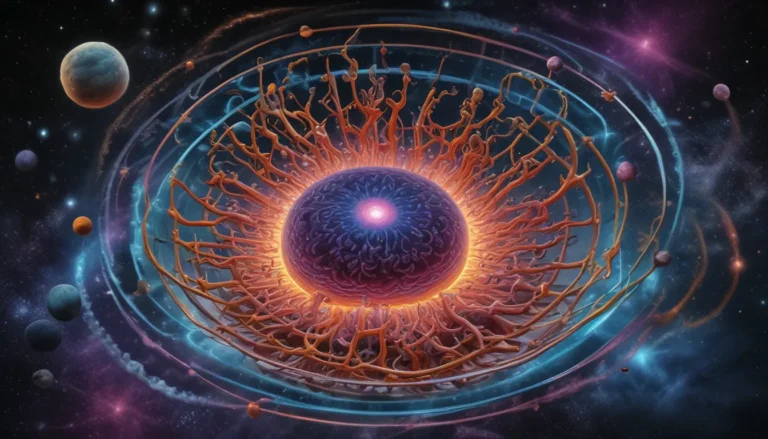A Note About Images: The images used in our articles are for illustration purposes only and may not exactly match the content. They are meant to engage readers, but the text should be relied upon for accurate information.
Welcome to the intriguing and mysterious world of wave function, a fundamental concept in physics that lies at the heart of quantum mechanics. In this article, we will delve into 18 fascinating facts about wave function that will shed light on its enigmatic nature and implications. From the dual nature of wave-particle duality to the uncertainty principle and the role of wave function in quantum computing, get ready to embark on a journey into the depths of the quantum realm.
Understanding Wave-Particle Duality
Wave function introduces us to the concept of wave-particle duality, where particles like electrons and photons can exist as both waves and particles simultaneously. This unique duality challenges traditional views of the physical world and prompts us to question the true essence of matter.
Exploring the Uncertainty Principle
The uncertainty principle, formulated by Werner Heisenberg, establishes a fundamental limit to the precision with which certain physical properties can be known simultaneously. This principle reflects the probabilistic nature of the wave function and highlights the inherent uncertainties in the quantum realm.
Embracing Superposition of States
According to wave function theory, particles can exist in a superposition of different states, allowing them to occupy multiple states simultaneously. Only upon measurement does the wave function collapse into a single state, revealing the probabilistic nature of quantum systems.
Unraveling Quantum Entanglement
Quantum entanglement is a mesmerizing phenomenon where particles become correlated to the point that the state of one particle cannot be described independently of others. This concept challenges conventional notions of space and time, showcasing the interconnected nature of particles at the quantum level.
Shedding Light on Wave Function Collapse
The act of measuring a particle’s properties leads to the collapse of its wave function into a specific state. This process, still a subject of debate among physicists, raises intriguing questions about the role of consciousness in the measurement process and highlights the mysterious nature of quantum mechanics.
Visualizing the Wave Function
While the wave function is a mathematical abstraction, various visualization techniques like probability density plots and orbital diagrams offer insights into its complex nature. These visual representations aid in understanding quantum phenomena and provide a glimpse into the behavior of particles at the quantum level.
The Significance of Schrödinger’s Equation
Schrödinger’s wave equation serves as a powerful tool in quantum physics, enabling the calculation and prediction of wave functions for particles. This equation forms the backbone of quantum mechanics, allowing scientists to explore the intricate properties of quantum systems and unlock their mysteries.
Marveling at Quantum Tunneling
Quantum tunneling, a curious phenomenon governed by the wave-like nature of particles described by the wave function, occurs when a particle passes through a seemingly impassable barrier. This behavior challenges classical physics and underscores the unique characteristics of quantum systems.
Delving into the Many-World Interpretation
The wave function gives rise to various interpretations of quantum mechanics, including the many-world interpretation. This intriguing concept posits that every possible outcome of a quantum measurement exists in parallel universes, each corresponding to a different value of the wave function.
Connecting Wave Function Collapse to Inflationary Cosmology
Some physicists propose a connection between wave function collapse and the theory of cosmic inflation, which explores the expansion of the universe and the quantum nature of particles. This link raises profound questions about the origins and fundamental nature of our universe.
Harnessing Wave Function in Quantum Computing
Wave function plays a crucial role in quantum computing by leveraging the superposition and entanglement properties of particles. Quantum computers harness the parallel processing capabilities of the wave function, offering unprecedented computational power and paving the way for innovative advancements.
Unveiling Quantum Teleportation with Wave Function
Quantum teleportation, reliant on wave function entanglement and superposition, enables the instantaneous transfer of particle properties to a different location without physical movement. This groundbreaking phenomenon showcases the transformative potential of quantum mechanics in communication and information processing.
Safeguarding Communication with Quantum Cryptography
The unique properties of wave function, such as entanglement, are harnessed in quantum cryptography to establish secure communication channels. The inherent randomness and uncertainty of the wave function make it resilient to eavesdropping and ensure the confidentiality of sensitive information.
Illuminating Quantum Simulations with Wave Function
Wave function simulations allow scientists to study complex quantum phenomena that are challenging to observe directly. By simulating the behavior of particles and systems under varying conditions, researchers gain valuable insights into the intricacies of quantum mechanics and contribute to advancements in diverse fields.
Pursuing the Theory of Everything with Wave Function
Wave function plays a pivotal role in the quest for a unified theory that integrates all fundamental forces of nature, known as the theory of everything. Understanding the enigmatic nature of the wave function is essential in unraveling the mysteries of the universe and forging a comprehensive framework for physics.
Bridging Wave Function with Quantum Field Theory
The close connection between wave function and quantum field theory elucidates the behavior of particles and their interactions at the quantum level. By describing quantum fields and their properties, the wave function offers valuable insights into the underlying principles governing the quantum world.
Navigating Multi-Particle Systems with Wave Function
In multi-particle systems, the wave function becomes increasingly complex, allowing for the description of entanglement, collective behavior, and other intricate phenomena. The mathematical formulation of the wave function in these systems offers a deeper understanding of the interplay between multiple particles and their dynamics.
Embarking on the Quest for a Unified Theory of Wave Function
While significant progress has been made in unraveling the mysteries of wave function, there is still much to explore. Physicists continue to develop theories that seek to unify the wave function with other fundamental concepts, such as gravity, in the pursuit of a comprehensive theory of quantum gravity.
Conclusion: The Enigmatic Tapestry of Wave Function
In conclusion, the wave function remains a captivating and indispensable concept in physics, offering insights into the intricate nature of quantum systems. From wave-particle duality to quantum entanglement and beyond, the wave function challenges our perceptions of reality and propels us into the realm of quantum mysteries.
As we journey through the 18 enigmatic facts about wave function, we uncover a tapestry of intriguing properties and implications that deepen our understanding of the quantum world. By exploring the fundamental principles and enigmatic phenomena associated with wave function, we embark on a quest for knowledge that transcends traditional boundaries and expands the frontiers of physics.
Join us in unraveling the enigmatic secrets of wave function and quantum mechanics as we continue to explore the fascinating world of physics and push the boundaries of human understanding.
FAQs: Demystifying Wave Function
-
What is a wave function?
A wave function is a mathematical description of the quantum state of a system, representing the probability distribution of finding a particle in a particular state. -
How does wave function describe particles?
The wave function describes the behavior and properties of particles at the quantum level, providing information about their position, momentum, and other observable quantities. -
What is wave-particle duality?
Wave-particle duality is the concept that particles like electrons and photons exhibit both wave-like and particle-like behavior, captured by the wave function as waves of probabilities. -
What is quantum entanglement?
Quantum entanglement is a phenomenon where particles become interconnected, leading to correlated states that transcend traditional notions of space and time. -
How does observation impact the wave function?
Observation causes the collapse of the wave function, determining a specific state from a range of possibilities and illustrating the effects of measurement in quantum mechanics.
As we journey through the enigmatic realms of wave function, let curiosity guide you in exploring the wonders of quantum mechanics and unraveling the mysteries of the universe. Dive into the depths of physics and embrace the enigmatic nature of wave function as we continue to illuminate the pathways of knowledge and discovery.






